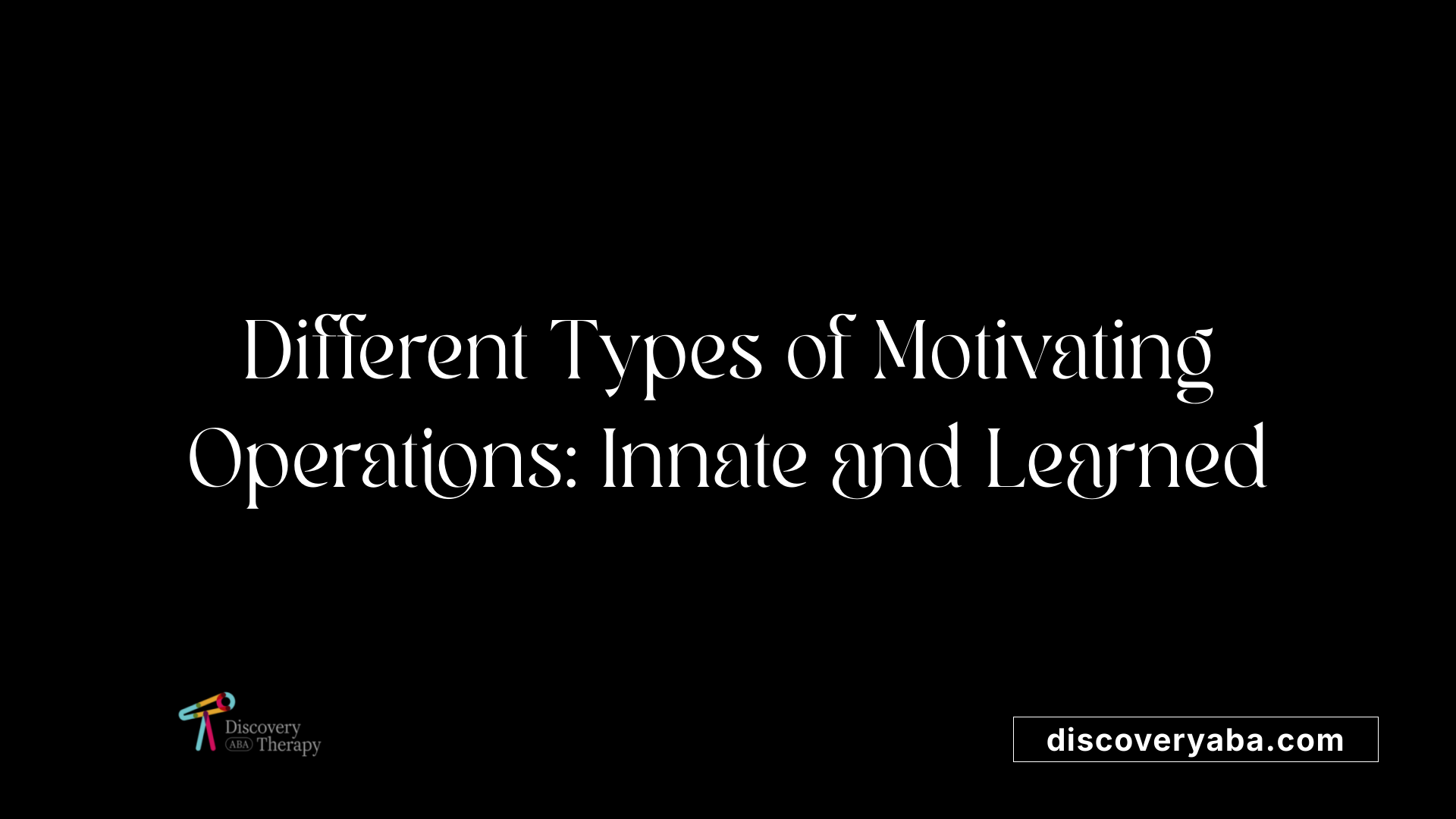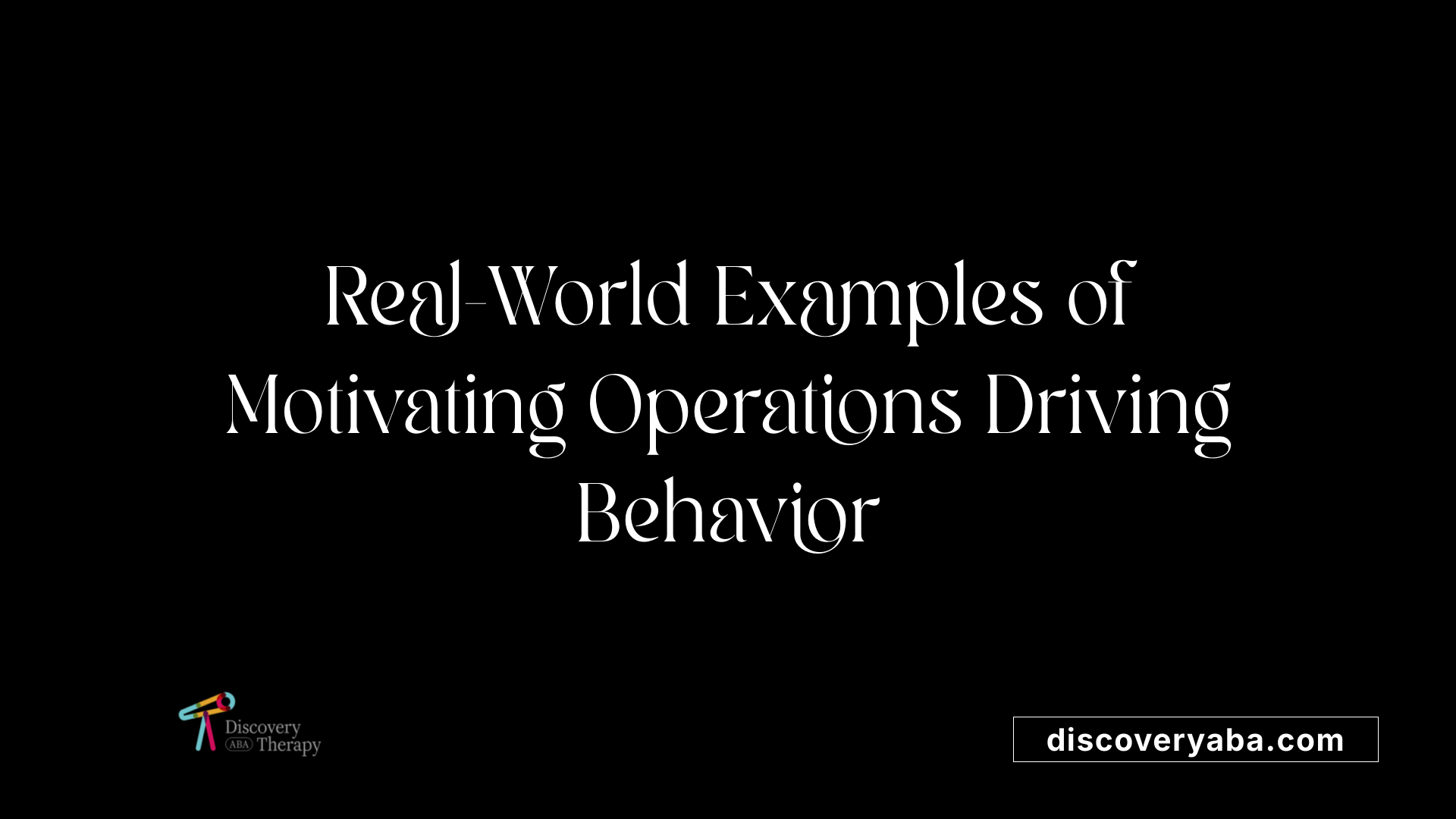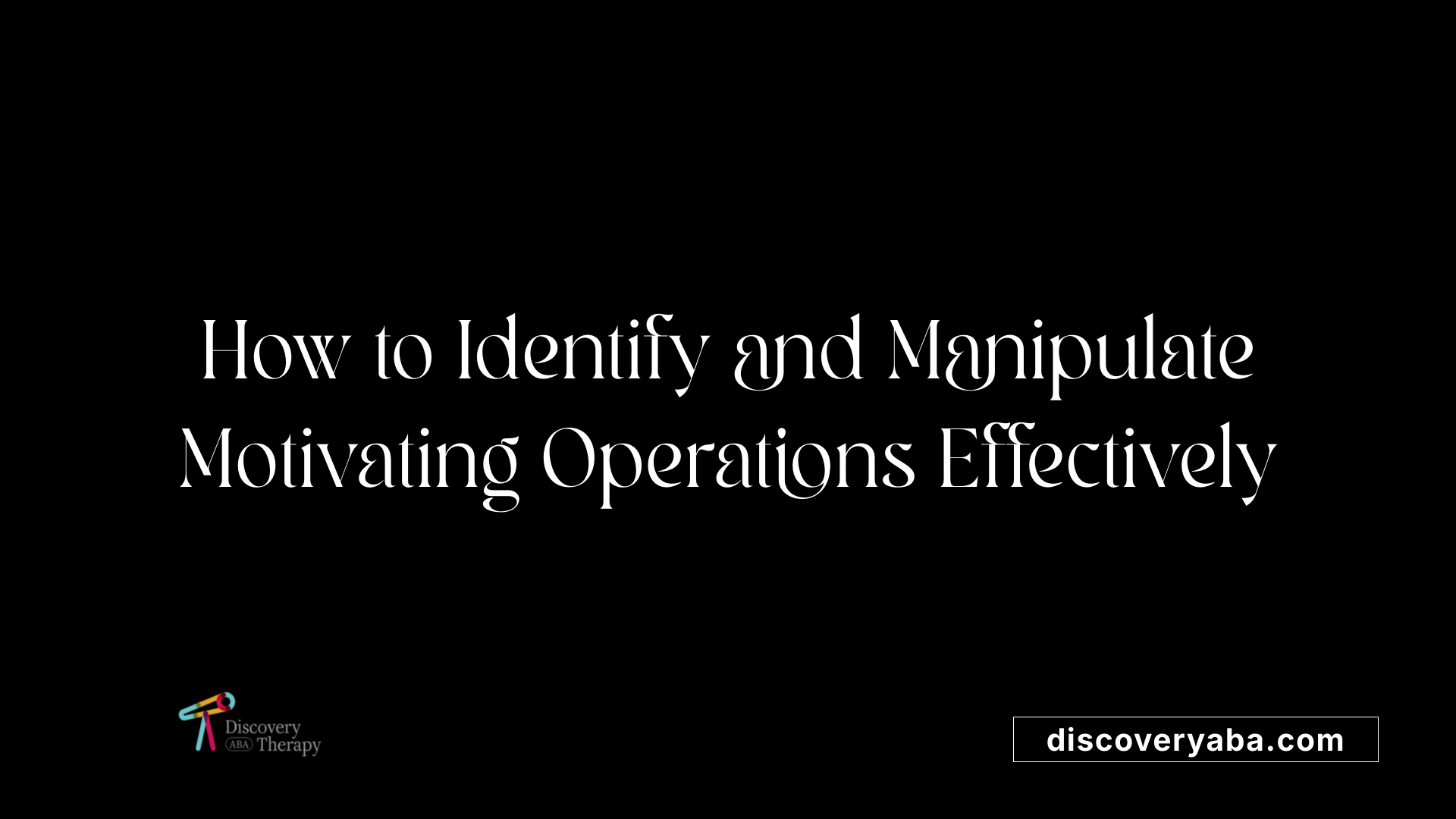What are motivating operations in ABA
Understanding the Power of Motivating Operations in Behavior Analysis

Introduction to Motivating Operations in ABA
Motivating Operations (MOs) are fundamental concepts in Applied Behavior Analysis (ABA) that explain how environmental and internal variables influence behavior. They shape the effectiveness of reinforcers and punishers, thereby directly impacting how behaviors are acquired or reduced. Recognizing and manipulating MOs allows clinicians and caregivers to tailor interventions that meet the motivation needs of individuals, leading to more effective behavior change strategies.
Defining Motivating Operations and Their Role in Behavior

What are motivating operations in ABA and how do they influence behavior?
Motivating Operations (MOs) are environmental events or conditions that change how desirable or effective a reinforcer or punisher is at a particular time. They shape behavior by affecting motivation—whether a person is more or less likely to seek out specific consequences.
For example, if someone is hungry, the value of food as a reward increases, making it more likely they will engage in behaviors that lead to obtaining food. Conversely, if the person is full, the motivation to seek food diminishes, reducing the likelihood of related behaviors.
MOs can be either unconditioned, such as natural drives like thirst or hunger, or conditioned, which depend on individual experiences. For instance, a clock signaling lunchtime can become a conditioned MO that increases the desirability of eating, even if the person is not physically hungry.
How MOs influence behavior
MOs directly affect how appealing or effective a stimulus is as a reinforcer or punisher. They alter the probability of engaging in specific behaviors by making certain stimuli more or less attractive based on current needs or states.
In ABA therapy, understanding and manipulating MOs helps professionals create environments that motivate desired behaviors or reduce problematic ones. For instance, depriving a child of a preferred toy temporarily can increase their motivation to request it appropriately.
The distinction between MOs and discriminative stimuli
While MOs change how much a stimulus functions as a reinforcer or punisher, discriminative stimuli signal whether reinforcement is available for a behavior. Discriminative stimuli tell us that a certain behavior can lead to a consequence, but they do not directly influence how much we want or need that consequence.
In summary, motivating operations are powerful environmental variables that influence our motivation levels and behavior by modifying the value of consequences. Recognizing and utilizing MOs is essential in designing effective interventions in applied behavior analysis.
Types of Motivating Operations: Unconditioned and Conditioned

What are the different types of motivating operations in ABA?
In Applied Behavior Analysis (ABA), understanding motivating operations (MOs) is essential for effective behavior intervention and assessment. There are two main types of MOs: unconditioned motivating operations (UMOs) and conditioned motivating operations (CMOs).
Unconditioned motivating operations (UMOs) are innate, meaning they do not require any prior learning or experience. These MOs are rooted in biological needs and evolutionary history. For example, hunger and thirst are UMOs because they naturally increase the desirability of food and water, respectively. When someone is deprived of a resource, the value of that resource as a reinforcer increases.
Conditioned motivating operations (CMOs), on the other hand, are learned through experience. They depend on an individual’s history and context. CMOs acquire their motivating properties by forming associations with other stimuli or events. For instance, a stimulus like a clock showing lunchtime, which becomes associated with food, can serve as a CMO. CMOs can modify the effectiveness of other stimuli or responses, acting as motivators based on past learning.
There are subtypes of CMOs, each with specific functions:
- Surrogate CMOs (CMO-S): These are stimuli paired with another MO to acquire its effectiveness. For example, a particular ringtone paired with hunger might make the ringtone itself motivating.
- Reflexive CMOs (CMO-R): These signals indicate worsening or improving conditions, and they influence how desirable a stimulus is. For example, seeing medication that signals an ongoing health issue can increase its value.
- Transitive CMOs (CMO-T): These establish or abolish the effectiveness of other stimuli as reinforcers. For example, the presence of a key (a CMO-T) can make a lock and keyhole more meaningful by establishing the need to unlock.
A useful way to differentiate these is by understanding their influence: EOs (establishing operations) increase the value or effectiveness of a reinforcer, whereas AOs (abolishing operations) decrease its value. Both UMOs and CMOs help practitioners manipulate environmental variables to motivate desired behaviors or reduce problematic ones.
| Type | Definition | Example | Function |
|---|---|---|---|
| UMO | Innate, from biological needs | Hunger increasing food value | Natural, evolutionary |
| CMO | Learned through experience | Clock signaling lunchtime | Acquired, experience-dependent |
| CMO-R | Signals worsening or improving conditions | Seeing medication signals health worsening | Reflexively influences stimulus value |
| CMO-T | Establishes or abolishes other stimuli’s effects | A key establishing the meaning of unlocking | Modifies the effectiveness of other stimuli |
| CMO-S | Paired with MO, acquires its effect | Clock paired with hunger | Becomes a motivator through pairing |
Understanding these distinctions allows behavior analysts and practitioners to better assess what motivates individuals and adjust environments for more effective behavior support.
Practical Examples of Motivating Operations in Action
 Motivating operations (MOs) play a crucial role in everyday behaviors, particularly in understanding what drives a person to act in specific ways. They influence how desirable a reinforcer appears and can change the likelihood of certain behaviors happening.
Motivating operations (MOs) play a crucial role in everyday behaviors, particularly in understanding what drives a person to act in specific ways. They influence how desirable a reinforcer appears and can change the likelihood of certain behaviors happening.
One common example involves primary reinforcers, such as food and water. When someone is hungry (an establishing operation), the value of food increases, making the person more motivated to obtain it. Conversely, when a person is full or satiated (an abolishing operation), the reinforcing value of food diminishes, and they are less likely to seek it.
States of deprivation and satiation significantly affect motivation. For instance, if a child has not played with a toy in a while (deprivation), their desire to play with it intensifies. Once they have been playing for some time and are full or tired, their motivation to continue decreases.
Conditioned stimuli can also influence motivation. These are learned and depend on experiences. For example, a clock signaling the time for lunch can become a surrogate CMO, increasing the desirability of food as the time approaches. Praise or positive feedback can act as conditioned motivators, boosting effort or engagement in tasks.
Real-world examples illustrate the variety of motivating operations. Feeling eye tightness or signs of an impending migraine (a CMO-R) can trigger avoidance behaviors like taking medication or resting. Similarly, a clogged toilet heightening the need for a plunger exemplifies a transitive CMO, where the presence of the problem establishes the importance of another object.
These examples demonstrate how both innate and learned environmental factors influence motivation, guiding behavior through changing values of stimuli. Recognizing and manipulating MOs can be especially helpful in applied settings, such as therapy or education, to promote desired behaviors and reduce problem behaviors.
| Type of Motivating Operation | Description | Real-World Example | Effect on Behavior |
|---|---|---|---|
| Unconditioned (UMO) | Innate, evolutionary | Hunger, thirst | Increase the likelihood of seeking food or water |
| Conditioned (CMO) | Learned through experience | Praise, clock signals | Can increase or decrease stimulus value, manipulating motivation |
| Reflexive (CMO-R) | Signaling worsening or improving conditions | Signs of migraine | Triggers avoidance or coping behaviors |
| Transitive (CMO-T) | Establishes or abolishes stimulus effectiveness | Cluttered toilet increasing plunger value | Establishes the importance of another stimulus |
| Surrogate (CMO-S) | Paired with other MOs to transfer effect | Clock time with hunger | Adds motivational value to a new stimulus |
Understanding how these examples work helps in applying behavioral strategies that motivate positive actions while discouraging undesirable ones.
Identifying and Manipulating Motivating Operations in Practice

How can motivating operations be identified and manipulated in ABA practice?
Motivating operations (MOs) play a critical role in shaping behavior by influencing the value of reinforcing stimuli. In Applied Behavior Analysis (ABA), professionals identify MOs primarily through keen observation of behavioral changes in various contexts. For example, an increase in problem behaviors when a child is hungry or a decrease when they are satiated signals a motivating operation related to food.
Assessment methods such as preference assessments and functional behavior assessments (FBAs) are fundamental tools. Preference assessments help determine which stimuli hold the most value for the individual at a given time, indicating the presence and strength of a motivating operation. FBAs analyze the contextual factors that precipitate behaviors, revealing environmental variables functioning as MOs.
Manipulating MOs involves altering environmental conditions to modify behavior. For instance, deprivation of a highly preferred item, like a toy or snack, temporarily establishes its value as a reinforcer (an EO), thereby increasing motivation to engage in targeted behaviors to obtain it. Conversely, satiation, such as after excessive consumption of food, functions as an abolishing operation (AO) by reducing the stimulus's reinforcing effectiveness.
Practitioners also employ systematic strategies, such as presenting or removing preferred items or activities, to evoke or diminish behaviors. For example, withholding access to a preferred activity during learning sessions can increase a child's motivation to complete tasks for access to that activity later. Additionally, understanding the different types of MOs—including unconditioned and conditioned, as well as their subtypes like CMO-R, CMO-T, and CMO-S—allows for tailored interventions.
Through careful assessment and strategic environmental modifications, ABA practitioners can effectively control motivating operations, thus enhancing learning, promoting desirable behaviors, and decreasing problematic actions. This integrated approach ensures interventions are responsive to the individual’s changing motivational states, leading to improved treatment outcomes.
| Assessment Method | Purpose | Examples |
|---|---|---|
| Preference Assessments | Identify preferred stimuli and possible MOs | Choosing preferred toys, food, activities |
| Functional Behavior Assessments (FBAs) | Understand environmental variables influencing behavior | Observing problem behaviors in different contexts |
| Environmental Modifications | Manipulate MOs to alter motivation | Deprivation or satiation of items or stimuli |
| Behavioral Strategies | Systematic control of MOs | Withholding or delivering preferred items to evoke or reduce behaviors |
Tracking changes across these methods allows clinicians to fine-tune interventions, creating motivational conditions that support skill development and reduce undesired behaviors.
Conclusion: Harnessing the Power of MOs for Behavior Change
What are motivating operations in ABA and how do they influence behavior?
Motivating Operations (MOs) in Applied Behavior Analysis (ABA) are events or conditions that modify the value or effectiveness of a reinforcer, thereby influencing the likelihood of a behavior occurring. They can increase (establish) or decrease (abolish) the desirability of a particular reinforcer, which in turn affects motivation and behavior.
For example, if a person is hungry, food becomes a more effective reinforcer, increasing the likelihood of behaviors that lead to obtaining food. MOs also include internal states like fatigue or emotional tension that can alter reinforcement effectiveness.
Understanding MOs helps behavior analysts and caregivers design interventions that are more effective by considering what truly motivates an individual at any given moment.
Why are MOs important in ABA interventions?
In ABA therapy, recognizing and manipulating MOs allows for better control over behavior. By understanding what motivates a person, practitioners can adjust environmental factors to reinforce desired behaviors or diminish problematic ones.
MOs help in designing strategies such as deprivation or satiation to increase or decrease motivation. For example, depriving a child of a preferred toy can serve as an establishing operation, making the toy more reinforcing during learning sessions.
Moreover, identifying the unconditioned and conditioned MOs provides insight into innate versus learned motivators, aiding in tailored intervention plans. Conditioned MOs, like a clock signaling lunchtime, can influence behavior similarly to natural MOs, such as hunger.
What are future directions and ongoing research in the understanding of MOs?
Research continues to explore how complex interactions of different MOs influence behavior in various settings. A particular focus is on refining assessment tools for MOs, like preference assessments and functional behavior assessments, to improve intervention precision.
Further investigation into conditioned MOs, including their subtypes like transitive, reflexive, and surrogate CMOs, aims to enhance strategies for behavior change.
Advancements in technology, such as real-time monitoring of environmental variables, are expected to facilitate dynamic manipulation of MOs, leading to more adaptive and personalized interventions.
Understanding and utilizing MOs remain crucial in developing comprehensive ABA programs that address motivation as a central component of behavior change.
Final Thoughts on Motivating Operations in ABA
Recognizing and effectively manipulating motivating operations is pivotal in ABA for fostering meaningful and sustainable behavior change. By understanding how environmental and internal states influence motivation, practitioners can develop interventions that are both responsive and personalized. Continued research and application of MOs promise to enhance therapeutic outcomes and improve quality of life for individuals receiving ABA services.
References
- What are Motivating Operations (MOs)? | Autism Resources
- B-12: Define and provide examples of motivating operations
- A Tutorial on the Concept of the Motivating Operation and its ...
- Motivating Operations in ABA Therapy: What, When & How - Blue ABA
- Motivating Operation - Study Notes ABA
- Motivating operations in the Journal of Organizational Behavior ...
- BHW Resources - Behavioral Health Works
- B-12: Define and provide examples of motivating operations
Does Your Child Have An Autism Diagnosis?
Learn More About How ABA Therapy Can Help
Find More Articles
Contact us
North Carolina, Nevada, Utah, Virginia
New Hampshire, Maine
Arizona, Colorado, Georgia, New Mexico, Oklahoma, Texas
.avif)




































































































